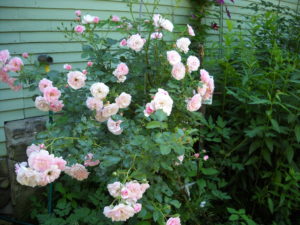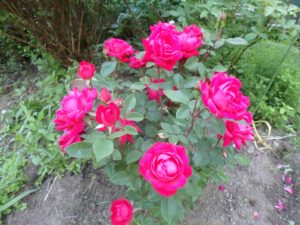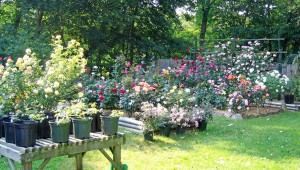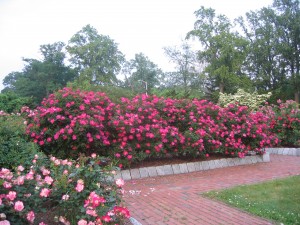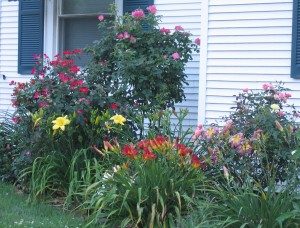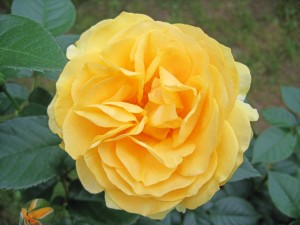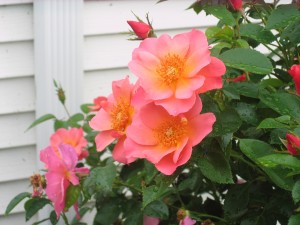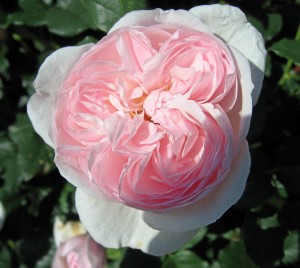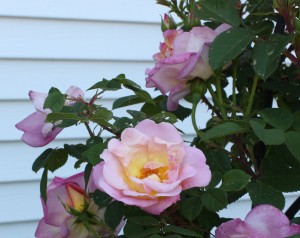Tips for Growing Better Roses This Summer
My grandmother and mom grew roses, even though their roses were often plagued by bugs and diseases. But in recent years the rose industry has produced a number of carefree roses that anyone with 6 hours of sunshine and even a slightly green thumb can grow.
Probably the first place to start a quest for a great rose would be at a good family-run garden center. Find the rose expert there, and ask about good varieties for your area. In general, fragrant roses tend to attract Japanese beetles and other insect pests. I personally like the ‘Knock Out” rose series. These roses are highly disease resistant and, in my experience, they attract few pest bugs. There are other disease-resistant varieties, of course.
If you live in a cold place where winters reach minus 25 or more, I’d look at the Canadian Explorer series of roses. These were developed in Ottawa, Canada and include those tough rugosa roses in their gene pool. Rugosa roses are also called beach roses, since they often grow in pure sand on the dunes of Cape Cod and elsewhere.
A good resource for selecting and maintaining problem-free roses is a book I like very much, Roses for New England: A Guide to Sustainable Rose Gardening by Mike and Angelina Chute. This book is full of information relevant to New England gardeners, and reading it would be a good way to educate yourself about roses. It reinforces what I have learned about roses over the years – and taught me some things I didn’t know.
So what do roses want? Good soil with a slightly acidic pH, plenty of sunshine, soil that is slightly moist all the time, a little fertilizer, and someone who loves them and is willing to pull off the beetles and drown them.
The soil that roses want is a good loam amended with compost. Dig a hole that is about two and a half feet wide and 18 inches deep. Keep half the soil and mix it with an equal amount of compost in a wheelbarrow or on a tarp.
You could send away a soil sample to determine the soil pH and to see what minerals are deficient, though that might take a few weeks before you get a response. Or you could just go to your local garden center and buy a kit for testing soil pH. Much of New England has acidic soil, but roses like something in the range of 6.0 to 6.8 – slightly acidic.
You can improve your soil pH by mixing in limestone (which is available in bags at your garden center). Mixing in a cup per rose is a good start, depending on your soil pH. I knew a rosarian who always buried a 4 inch square scrap of Sheetrock (wallboard) beneath each rose to provide calcium and improve soil pH over time. A cup of bone meal or rock phosphate at planting time will add phosphate, a mineral that roses need.
Roses need sunshine to do well, the more the better. The Chute’s book taught me that if you have to choose morning sun or afternoon sun, go for morning sun. That way the dew dries up more quickly – and fungal diseases, which love wet leaves, are minimized naturally. Six hours of sun is considered adequate, but the Chutes mention that roses with fewer petals need less sun to bloom.
I have a rose right near my front door – and the hose that is connected there. It has bloomed well for decades, in part, because every time I fill a bucket, wash the car or use the hose, I give the rose a nice drink. Roses love water. I have a watering wand on the hose so that I can direct water to its base, and not wet the leaves. In dry summers watering roses is key. How much? At least 5 gallons per week for a mature rose.
I rarely fertilize my roses, but the Chute’s book says that fertilizing regularly increases blooming. I might try a couple of applications of an organic liquid fish fertilizer this summer. Be aware that too much fertilizer pushes fast growth that is more susceptible to diseases and insect damage.
What else should you consider when selecting roses? I like roses grown on their own roots, not grafted onto root stock. If the plant dies down to the soil over winter, a rose will sometimes send up shoots from the roots, which are different from the rose you planted if you buy grafted roses.
Also read the tag carefully to see if it is a one-time bloomer each season, or a re-bloomer. Some roses like the Knock-Out roses bloom for most of the summer. Be sure to cut off blossoms after flowering to encourage more blossoms.
Finally, now is the season to cut off any brown, dead portions on stems – most roses suffer a little winter damage. Cut above an emerging leaf.
I’m an organic gardener which means I don’t spray my roses, not for fungal diseases, not for insect pests. I firmly believe that if you have a rose in good soil with good sunshine and adequate water, your roses will be healthy and not attract many insects.
Henry is at the Chelsea Flower Show in London this week, and will not be answering questions. Read his report on the show next week!
Growing Roses
Before we launch into this week’s article…
Gardening Classes with Henry
Lebanon College: Gardening: A Practical Workshop. Garden writer Henry Homeyer will teach you the basics of organic vegetable and flower gardening. From garden design to seed-starting , planting, watering, weeding, mulching, and harvesting, this course will give each student practical knowledge of gardening. Tuesday nights from 6:30-8:30 for 5 weeks, April 3-May 2.Contact Lebanon College to reserve a spot for this5-part workshop www.lebanoncollege.edu or call 603-448-2445.
AVA Gallery, Lebanon. Henry will teach 3 classes at AVA Gallery this spring. You may sign up for one or all of these workshops:
Sculpting the Living Landscape: Starting Flowers from Seed
April 9; Monday, 6:30–8:30pm; One 2-hour class
Sculpting the Living Landscape: Perfect Perennials for the Upper Valley Garden
April 23; Monday, 6:30–8:30pm; One 2-hour class
Sculpting the Living Landscape: Organic Techniques for Enriching Soil and Managing Pests
May 7; Monday, 6:30–8:30pm; One 2-hour class
For more information go to www.avagallery.org or call 603-448-3117.
Growing Roses
When I read a new gardening book I generally read it with a pen in hand. If I see something of special interest, I make a check mark in the margin. If I read something I agree with, and want to pass on to others, I underline.
When I learn something important, I make a star in the margin. I recently finished reading – and marking up – Roses for New England: A Guide to Sustainable Rose Gardening by Mike and Angelina Chute of East Providence, R.I. The whole book is marked up and has several stars. If you’ve been leery of growing roses, this book de-mystifies the process and gives you all the information you need to succeed.
March may seem like a funny time for reading about roses, but it makes sense to me: we have time to read now, before the gardening season begins. And if you want to order special roses, it takes some time make and receive an order. Bare root roses need to be planted while dormant – and while available. The Chutes recommend planting bare root roses in April or October.
The book describes 6 easy steps to success:
1. Select good plants. They have 150 suggestions for roses that are winter hardy and disease resistant. Steer clear of roses that have spots, blemishes or disease. Don’t buy a potted rose with wrinkled canes – it’s dehydrated.
2. Start with good soil. Test the pH: it should be between 6 and 6.8. Add lots of organic matter into a large planting
hole, and some limestone if needed.
3. Plant in a sunny location. Six hours of sunshine is needed for lots of blossoms.
4. Provide plenty of water. Water deeply, up to 5 gallons per week in hot times. Do not get the leaves wet.
5. Fertilize 3 or 4 times in the course of a summer. They use a combination of 10-10-10 and slow-release organic fertilizers, and sometimes give liquid fish fertilizers as a supplement to get more blossoms. As an organic gardener, I do little fertilizing and still do fine – my soil is good.
6. Manage pests and diseases by “maintaining strong, healthy roses right from the start… Healthy plants have tougher immune systems”.
Although the authors recognize that some gardeners will want to use chemicals, they use no chemicals for insects, and rarely for fungus. A stiff stream of water from the hose will wash off aphids and spider mites, they explain, and hand picking beetles is better than spraying. If you spray for insects, the beneficial insects are killed along with the pest insects.
If you purchase bare root roses, you may be troubled by the question of how deep to plant them (I know I have been, at times). We’ve all learned not to bury the trunk flare (the natural base) of a tree or shrub, but roses are not the same. Looking at a bare root rose, you can see where it has been grafted onto a rootstock, which is called the bud union. That union should be 2-4 inches below the final grade of the soil. The colder the climate, the deeper the roots. I plant 4 inches deep for Zone 4.
Pruning roses is another problem area for many gardeners, but one easily and simply explained in Roses for New England. Mike and Angelina explain that some roses only bloom once a year, while others bloom repeatedly. For one-time bloomers, prune after blooming. For the others, you should prune early in spring, and then after each flush of blossoms.
Pruning is important for rose health, too. To prevent fungal diseases, prune to open up the bush and allow good air circulation. You can direct growth by pruning just above a bud that is pointing away from the center of the bush, instead of one pointing in towards it.
I was fascinated to read (stars in the margin of my book) that the Chutes know how to prune repeat-blooming roses to get a flush of blooms on a certain date. Each rose has a certain time interval between bloom cycles. Cutting off all spent blossoms (and pruning back the canes) after a first blooming will stimulate a second set of blossoms. The more petals, the longer the period.
The simplest floribunda roses take just 40 days to re-bloom, while heavily petaled hybrid tea roses can take 55 days. Learn the intervals on your roses, and you can have them bloom for your August tea party. The average time for
re-blooming roses is 50 days. Of course, 2 weeks of cold rain can upset that schedule.
I like that this book explains that you don’t need a hazmat suit to protect yourself from all the chemicals that were used in the past. Buy roses that are disease resistant, plant them well, and they will resist most diseases – and make you swoon. To learn more about roses, go to the authors’ Web site, www.rosesolutions.net. You can order your own copy of the book there, too.
Henry’s WEB EXTRAS:



